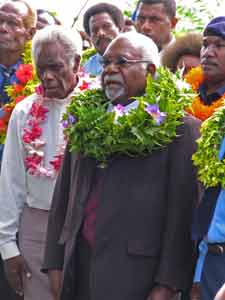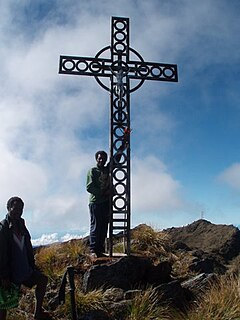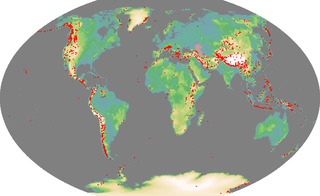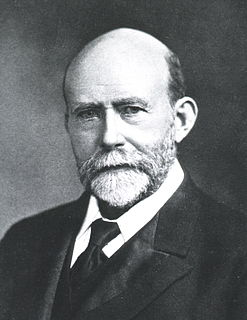
Mount Waddington, once known as Mystery Mountain, is the highest peak in the Coast Mountains of British Columbia, Canada. Although it is lower than Mount Fairweather and Mount Quincy Adams, which straddle the United States border between Alaska and British Columbia, Mount Waddington is the highest peak that lies entirely within British Columbia. It and the subrange which surround it, known as the Waddington Range, stands at the heart of the Pacific Ranges, a remote and extremely difficult set of mountains and river valleys.

The Territory of Papua comprised the southeastern quarter of the island of New Guinea from 1883 to 1975. In 1883, the Government of Queensland annexed this territory for the British Empire. The United Kingdom Government refused to ratify the annexation but in 1884 a Protectorate was proclaimed over the territory, then called "British New Guinea". There is a certain ambiguity about the exact date on which the entire territory was annexed by the British. The Papua Act 1905 recites that this happened "on or about" 4 September 1888. On 18 March 1902, the Territory was placed under the authority of the Commonwealth of Australia. Resolutions of acceptance were passed by the Commonwealth Parliament, who accepted the territory under the name of Papua.

Sir Paulias Nguna Matane, was the eighth Governor-General of Papua New Guinea, serving from 29 June 2004 to 13 December 2010. His memoir My Childhood in New Guinea has been on the school curriculum since the 1970s, and for many years he wrote a column in the newspaper The National.

Mount Wilhelm is the highest mountain in Papua New Guinea at 4,509 metres (14,793 ft). It is part of the Bismarck Range and the peak is the point where three provinces, Simbu, Jiwaka and Madang, meet. The peak is also known as Enduwa Kombuglu, or Kombugl'o Dimbin, in the local Kuman.
Tourism in Papua New Guinea is a fledgling industry but there are attractions for the potential visitor which include culture, markets, festivals, diving, surfing, hiking, fishing and the unique flora and fauna. Papua New Guinea receives an increasing number of visitors each year, with approximately 184,000 international arrivals in 2015.

The New Guinea campaign of the Pacific War lasted from January 1942 until the end of the war in August 1945. During the initial phase in early 1942, the Empire of Japan invaded the Australian-administered territories of the New Guinea Mandate and Papua and overran western New Guinea, which was a part of the Netherlands East Indies. During the second phase, lasting from late 1942 until the Japanese surrender, the Allies—consisting primarily of Australian and US forces—cleared the Japanese first from Papua, then the Mandate and finally from the Dutch colony.

Sir John Hubert Plunkett Murray KCMG was a judge and Lieutenant-Governor of Papua from 1908 until his death at Samarai.

Finisterre Range is a mountain range in north-eastern Papua New Guinea. The highest point is ranked 41st in the world by prominence, and has an elevation of 4,150 m. Although the range's high point is not named on official maps, the name "Mount Boising" is used locally. This peak was possibly the most prominent unclimbed peak in the world until the first known ascent on 25 June 2014.

The Seven Second Summits are the second-highest mountains of each of the seven continents. All of these mountain peaks are separate peaks rather than a sub-peak of the continents' high point. The Seven Second Summits are considered by many mountaineers and geographers as a much harder challenge than the traditional Seven Summits.
The Roman Catholic Archdiocese of Port Moresby is a Latin Metropolitan Archdiocese in Papua New Guinea, yet remains depandent on the missionary Propaganda Fide Roman Congregation.

Mount Albert Edward is a 3,990-metre-high (13,091 ft) mountain in the Wharton Range in Central Province, Papua New Guinea. The mountain consists of two peaks about 400 metres apart, a cross marks the top of the slightly higher western peak and a trig station marks the eastern peak. The mountain lies approximately 120 km north of Port Moresby.

An ultra-prominent peak, or Ultra for short, is a mountain summit with a topographic prominence of 1,500 metres (4,900 ft) or more; it is also called a P1500. There are approximately 1,524 such peaks on Earth. Some well-known peaks, such as the Matterhorn and Eiger, are not Ultras because they are connected to higher mountains by high cols and therefore do not achieve enough topographic prominence.

Mount Suckling or Goropi, is the highest peak of the Goropu Mountains, part of the Owen Stanley Range in south-eastern Papua New Guinea. It lies about 250 kilometres (160 mi) east of Port Moresby. Situated on a relatively narrow peninsula, it lies only about 60 km (40 mi) from the sea to both the north-east and the south. While not the highest peak in the Owen Stanley Range, it is the most topographically prominent peak in the range, and it is in fact the third most prominent peak on the island of New Guinea. The peak rises above the timberline, while its lower slopes are well-forested.
Sport in Papua New Guinea is an important part of the national culture. Rugby league is the most popular sport in Papua New Guinea.

Sergey Anatolyevich Kofanov is a Russian mountaineer.

Puncak Mandala is a mountain located in Papua, Indonesia. At 4,760 metres (15,617 ft), it is the highest point of the Jayawijaya (Orange) Range. Following Mount Carstensz 350 km to the west, Mandala is the second highest freestanding mountain of Oceania, Australasia, New Guinea and Indonesia.

Puncak Jaya or Carstensz Pyramid (4,884 m [16,024 ft]) is the highest summit of Mount Jayawijaya or Mount Carstensz in the Sudirman Range of the western central highlands of Papua Province, Indonesia. Other summits are East Carstensz Peak (4,808 m [15,774 ft]), Sumantri (4,870 m [15,980 ft]) and Ngga Pulu (4,863 m [15,955 ft]). Other names include Nemangkawi in the Amungkal language, Carstensz Toppen and Gunung Soekarno.

The Papuan Peninsula, also known as the Bird's Tail Peninsula, is a large peninsula in Papua New Guinea, southeast of the city of Lae, that makes up the southeastern portion of the island of New Guinea. The peninsula is the easternmost extent of the New Guinea Highlands and consists largely of the Owen Stanley Range, with peaks such as Mount Victoria and Mount Suckling. On the south coast is Port Moresby, the capital and largest city of Papua New Guinea.
Riall W. Nolan is an American anthropologist, an ameritus professor of anthropology at Purdue University, USA and a faculty member in the MPhil program in International Development at the University of Cambridge, UK. A scholar of international development, cross-cultural adaptation, and applied anthropology, he has conducted research on issues of change and development in Eastern Senegal, Papua New Guinea, Sri Lanka, Tunisia, Somalia, Cote d’Ivoire, Guinea, Indonesia, Thailand, and Western Siberia. His work as a researcher and project specialist has included community led development initiatives with the Peace Corps, USAID, the World Bank, and numerous university and local NGO partners.

Lonely Planet is a large travel guide book publisher. As of 2011, the company had sold 120 million books since inception and by early 2014, it had sold around 11 million units of its travel apps.

The International Standard Book Number (ISBN) is a numeric commercial book identifier which is intended to be unique. Publishers purchase ISBNs from an affiliate of the International ISBN Agency.






















